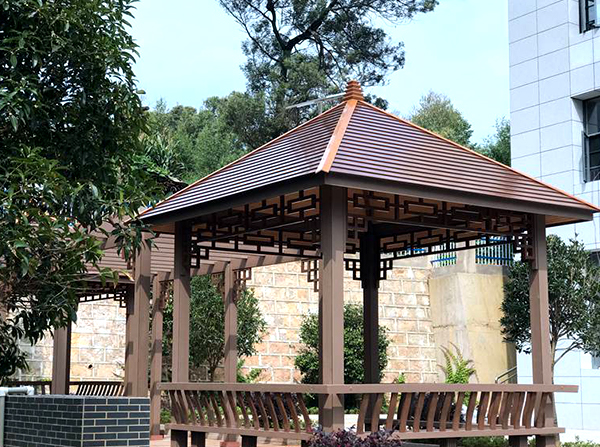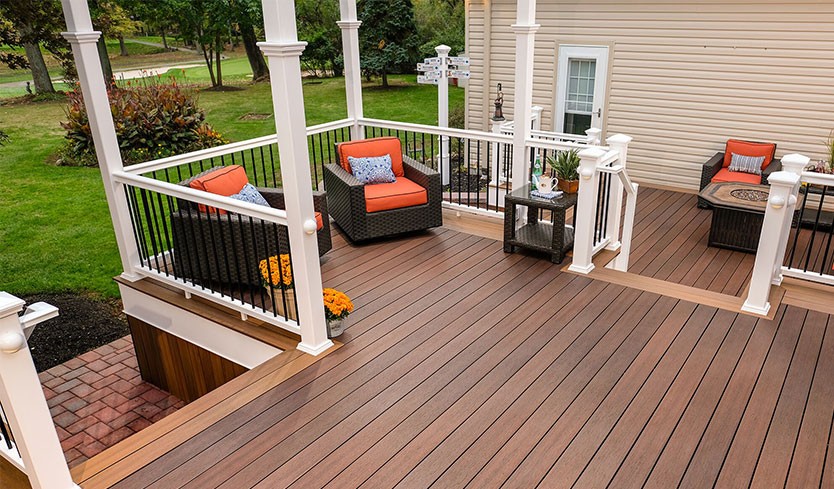Wood-plastic composites (WPC) are a fascinating innovation in materials science, combining wood fibers or wood flour with thermoplastics such as polyethylene (PE), polypropylene (PP), polyvinyl chloride (PVC), and polylactic acid (PLA). This fusion creates a unique material that offers a sustainable and versatile alternative to traditional wood. WPCs can also include other fillers, both lignocellulosic (derived from plant fibers) and inorganic, broadening their applications and performance characteristics. WPCs fall under the broader category of natural fiber plastic composites (NFPC), which also incorporate cellulose-based fibers like peanut hulls, bamboo, and rice straws.
Table of Contents
History of Wood-Plastic Composites
The development of WPCs dates back to the 1960s, with significant milestones achieved by Milan-based company Converma. They invented and patented the wood-plastic process, branding their creation as ‘Plastic-Wood.’ This marked the beginning of WPCs as a commercially viable material. Shortly thereafter, Icma San Giorgio made strides in refining the process by adding wood fibers to thermoplastics, paving the way for modern wood-plastic composite products.
This early innovation set the stage for WPCs to become a prominent material in the industry. The initial focus was on developing a product that could leverage the benefits of both wood and plastic, providing a more durable and versatile alternative to solid wood. The evolution of this material has led to a wide array of applications and continues to drive advancements in both manufacturing processes and product performance.
Uses of Wood-Plastic Composites
WPCs are sometimes referred to as composite wood, and their use has expanded significantly since their introduction. While their initial application was primarily in outdoor decking, WPCs are now employed in various other applications, including railings, fences, landscape timbers, cladding and siding, park benches, and even indoor furniture.
In North America, WPC decking became popular in the 1990s, with manufacturers promoting its environmental benefits and lower maintenance requirements compared to traditional wood. Unlike solid wood, which needs regular treatment to prevent decay, WPC decking offers a more durable and maintenance-free option. This makes it an attractive choice for both residential and commercial outdoor spaces.
WPCs are also used to construct wood-plastic composite wall panels, which can be integrated into building facades and interior walls. These panels provide a visually appealing alternative to conventional building materials and are valued for their durability and ease of maintenance. In addition, the versatility of WPCs allows them to be molded into various shapes and designs, which makes them suitable for a large series of applications.

Production of Wood-Plastic Composites
The production of WPCs involves a process where ground wood particles are thoroughly mixed with heated thermoplastic resins. The most common production method is extrusion, where the material is forced through a mold to create the desired shape. Alternatively, injection molding is used to produce intricate components.
WPCs can be manufactured using both virgin and recycled thermoplastics. Common thermoplastics used include high-density polyethylene (HDPE), low-density polyethylene (LDPE), polyvinyl chloride (PVC), polypropylene (PP), acrylonitrile-butadiene-styrene (ABS), polystyrene (PS), and polylactic acid (PLA). Among these, polyethylene-based WPCs are the most prevalent due to their favorable properties and wide availability.
Additives play a crucial role in tailoring this kind of properties of WPCs. Colorants, coupling agents, UV stabilizers, foaming agents, blowing agents, and lubricants are added to enhance performance and appearance. For example, colorants can provide a range of aesthetic options, while UV stabilizers help prevent degradation from sunlight exposure.
Extruded WPCs can be produced as solid or hollow profiles, while injection-molded components are used in a variety of products, from automotive parts to mobile phone casings. In some production facilities, components are first formed into pellets, which are then re-melted and molded into their final shape. Other facilities might use a single step of mixing and extruding to produce the finished product.
The production temperature for WPCs is typically lower than that for conventional plastics, due to the presence of organic materials. For instance, the processing temperature for WPCs is usually around 28°C (50°F) lower than for unfilled plastics. This helps prevent issues such as shear or discoloration. The ratio of wood to plastic in the composite affects the melt flow index (MFI), with higher wood content leading to a lower MFI.

Pros and Cons of Wood-Plastic Composites
Examining WPCs through the lens of common applications such as composite decking and wood-plastic sandwich panels reveals both benefits and drawbacks:
Pros:
Sustainability: WPCs are often made from recycled plastics and waste materials from the wood industry, contributing to environmental sustainability. This recycling process helps extend the life of waste materials, although the added polymers and binders make it challenging for WPCs to recycle once again.
Versatility: WPCs can be molded into a wide range of shapes, including complex curves, which is a significant advantage over traditional wood. This versatility makes WPCs suitable for various design applications.
Low Maintenance: Unlike traditional wood, WPCs do not require painting or staining. They come in a variety of colors, with grey and earth tones being the most popular. This low-maintenance feature makes them a practical choice for many applications.
Cons:
Durability Issues: WPCs with hydrophilic matrices, such as those made with PLA, can absorb water, potentially reducing mechanical stiffness and strength. While acetylation can improve performance in humid conditions, WPCs are still prone to UV degradation and staining.
Recycling Challenges: Despite their use of recycled materials, WPCs are difficult to recycle due to the added polymers and binders. This presents a challenge for sustainability, as the end-of-life management of WPCs requires careful consideration.

About HOSUNG WPC: Pioneering Innovation in Composite Materials
HOSUNG WPC is a leading name in wood-plastic composite materials, specializing in wood-plastic composite decking and wood-plastic composite wall panels. Our commitment to innovation and sustainability sets us apart in the industry.
We utilize advanced technology to produce high-quality plastic and wood composite materials that combine durability with aesthetic appeal. Our products, including deck plastic wood composites, are designed to withstand harsh weather conditions while offering a sustainable alternative to traditional wood.
At HOSUNG WPC, we prioritize the use of recycled plastic wood in our manufacturing processes, ensuring that our products are both eco-friendly and cost-effective. Whether for residential or commercial applications, our wood-plastic composite decking and wall panels provide superior performance and low maintenance, making them ideal choices for modern construction needs.
By focusing on innovation and environmental responsibility, HOSUNG WPC is dedicated to transforming the industry with cutting-edge, sustainable solutions.
In summary, wood-plastic composites (WPCs) and their derivatives like wood plastic composite decking, plastic and wood composite materials, and recycled plastic wood offer exciting possibilities for modern construction and design. While they come with some limitations, their adaptability, sustainability, and performance make them a valuable choice in a variety of applications.








